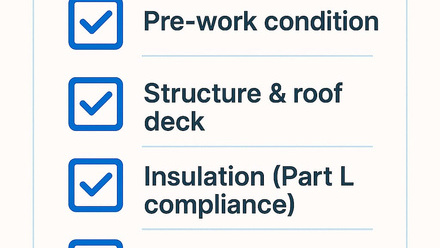As a roofing contractor, securing professional indemnity (PI) insurance is essential to protect your business against claims of professional negligence. This type of insurance covers legal costs and compensation payments if a client alleges that your work or advice has caused them financial loss. To ensure you get the best terms from an insurance broker, it is important to demonstrate good risk management practices.
In this short article, Tanya Cooper breaks down how you can achieve this.
Demonstrating good risk management
Written procedures for Design Work Management: Having comprehensive written procedures in place is crucial. These should outline how you manage the design work of your projects. Clear documentation shows insurers that you have structured processes to mitigate risk associated with design errors.
Qualifications of Involved Personnel: Detail the qualifications of all personnel involved in the project. This includes accreditations, certifications, training and relevant experience. Registration to professional bodies such as NFRC CPS will provide further evidence that your business has passed a level of scrutiny to be deemed competent in the work they undertake. Providing this information demonstrates that your team is competent and knowledgeable, reducing perceived risk for insurers.
Contractual Management
Contract Review Process: Implement and document thorough processes for reviewing contracts. Ensuring that all contracts are meticulously reviewed can prevent misunderstandings and legal issues later on. Highlight how you systematically check for potential risks and address them before proceeding.
Exclusion of “Fitness for Purpose” Obligations: Where possible, exclude ‘fitness for purpose’ obligations in your contracts. This clause can imply a guarantee that your work will achieve a specific result, which can be risky. Instead, aim to include terms that define the scope and intent of the design work undertaken.
Express Statements of Reliance: Include clear statements in your contract specifying which information and documents you have relied upon when performing design works. This can help limit liability by setting clear boundaries on the information basis for your design decisions.
Identifying Low Risk Contracts
Segregating Design and Non-Design Work: Identify contracts that did not include a design element or were covered by project-specific insurances. These contracts generally present little or no insurance risk. By segregating and documenting these, you can negotiate favourable terms for lower-risk portions of your work.
Breakdown of Work Categories: Provide a detailed breakdown of your work by category (e.g. public/private sector, high/low risk, residential, commercial, industrial etc.) This helps insurers to better understand your risk profile and can lead to more reasonable cover for less risky parts of your business. By using your NFRC CPS portal to its full potential, you can maintain this information, making it easier for you to locate all your works information in one place.
Agreements with External Consultants
Liability Confirmation from Design Consultants: If you engage external design consultants, ensure there are agreements in place confirming their liability to you for professional negligence. This shifts some risk away from your business.
Evidence of Consultant’s PI Insurance: Request and maintain evidence of PI insurance from your external consultants. This provides an additional layer of security and demonstrates to your insurer that third parties involved in your projects are also insured against negligence.
Presenting a clear and concise business profile with your insurance broker is key to building a strong relationship. By implementing and demonstrating these risk management strategies, you can present a strong case to your insurance broker for securing the best possible terms for your PI insurance. Proper documentation, contractual clarity and thorough qualification records are key elements in minimizing perceived risks and negotiating favourable insurance premiums. Alongside these strategies, always be open about your claim’s history giving details of any previous claims and measures you have taken to prevent a recurrence.
Finally, it is important to keep good records, as potential claims could arise months or even years after the works are completed. This not only protects your business but also enhances your reputation as a professional and reliable roofing contractor.




